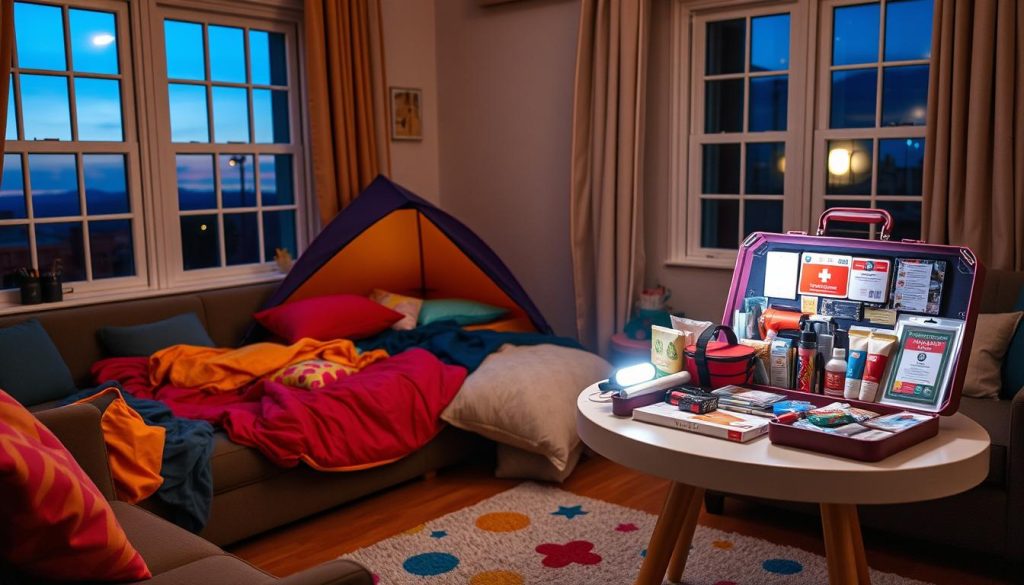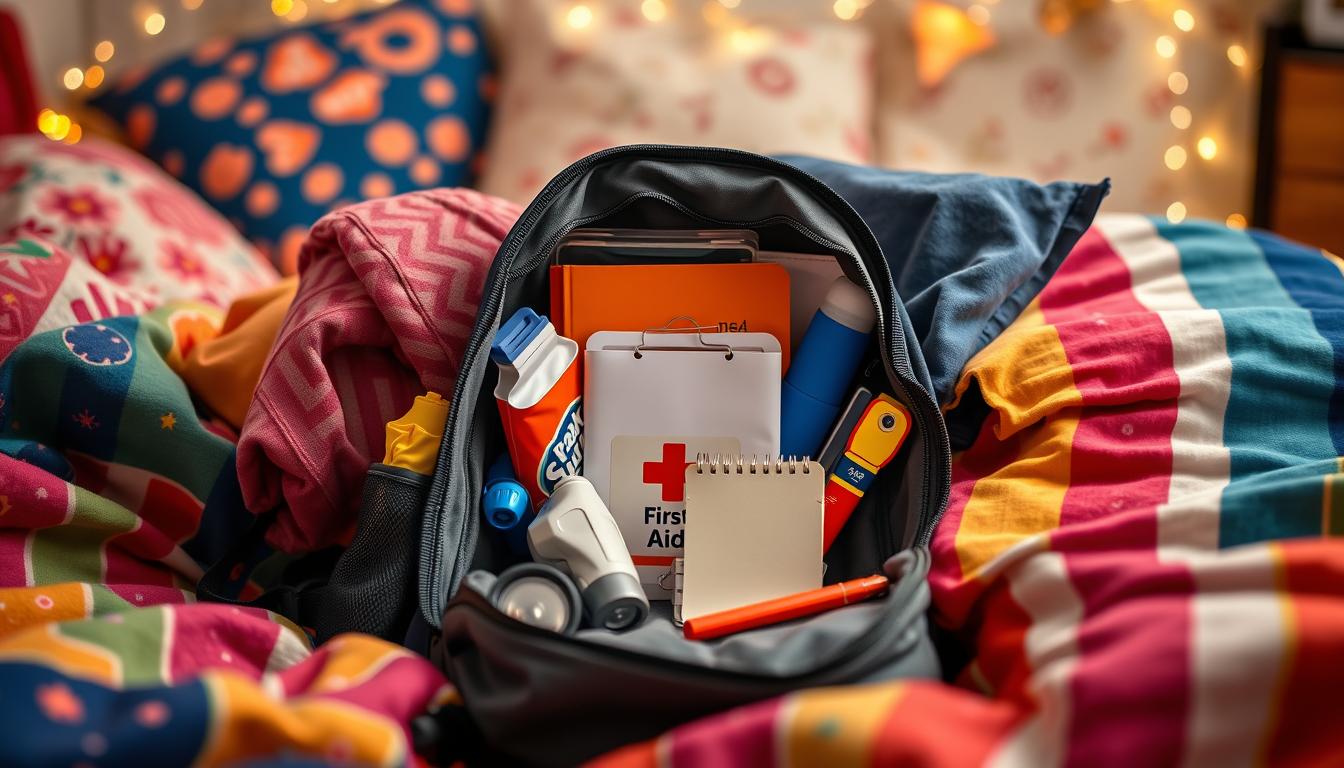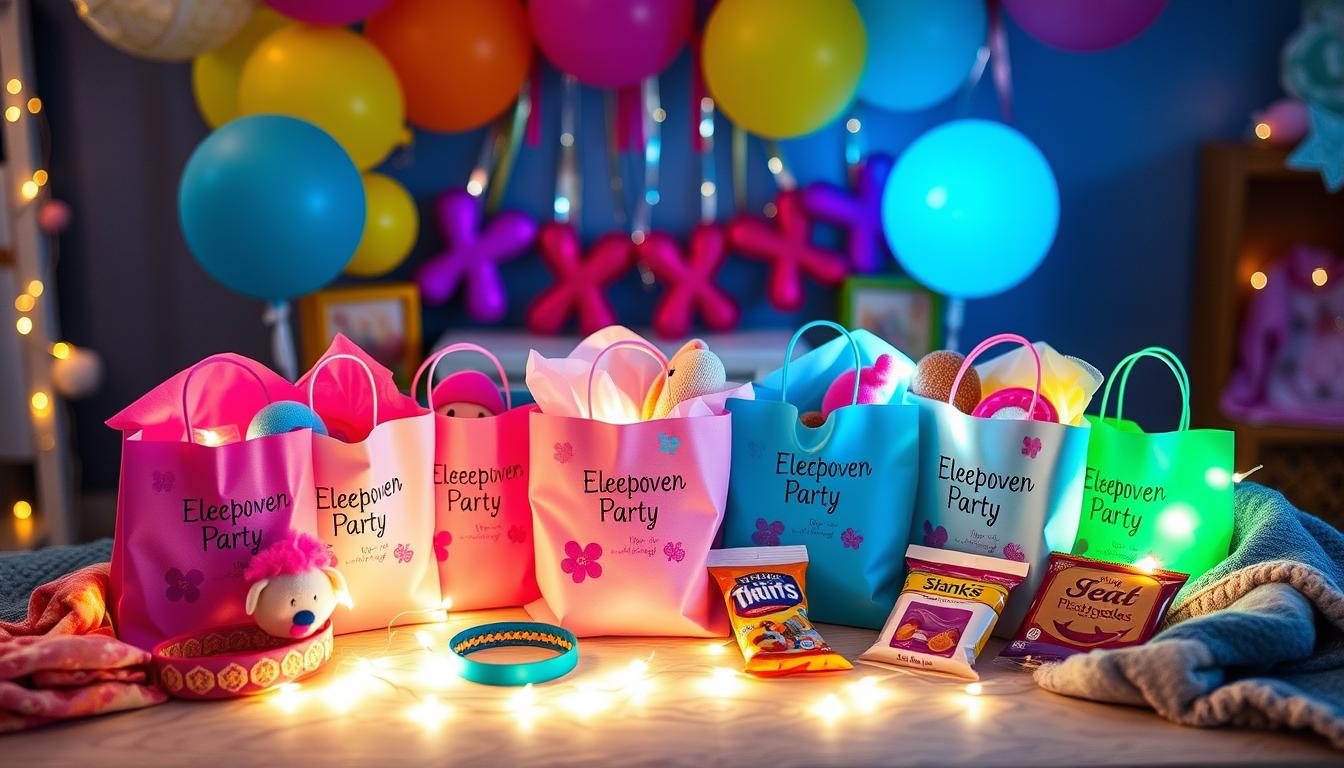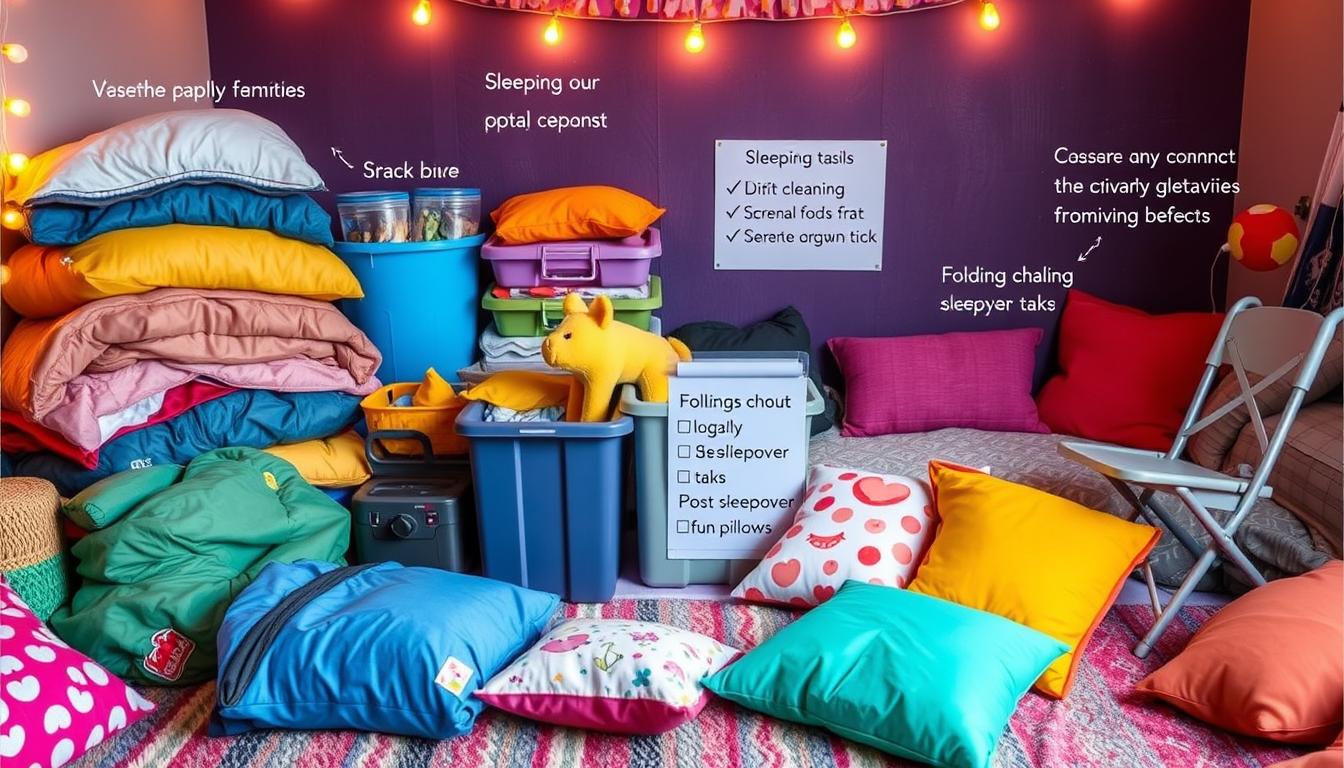Are you ready for the unexpected at your child’s sleepover? Sleepovers are more than fun; they’re big social steps with risks. It’s key to have a good sleepover emergency guide to keep your child safe and happy.
As kids have more sleepovers, knowing how to keep them safe is vital. With Type 1 diabetes in 1 in 300 kids in the U.S., and over 80% of parents worried, planning is critical. This guide will help you prepare your child and yourself for a safe sleepover.
Understanding the Importance of Sleepover Emergency Preparation
It’s key for parents and kids to get ready for sleepover emergencies. These events are big social steps, but they can also be risky if not planned well. Knowing these risks helps parents keep everyone safe and informed.
Social Milestones and Risks
Sleepovers are big for kids as they make friends. But, they can also be dangerous. A scary case in Oregon showed how fast things can go wrong. A man was accused of giving kids drugs in smoothies.
One kid noticed something odd and told her parents. This shows why it’s important to watch out for safety, as kids learn at different rates.
Essentials of Safety Planning
Having a good safety plan for sleepovers is a must. Ask about the supervision before your child goes. Dr. Rebekah Diamond says parents should know the place their kids are going to.
Setting clear rules and talking with other parents can help a lot. Good planning can cut down health risks by 40%.
Age-Appropriate Considerations
It’s important to think about the age of the kids when planning. Young ones might not say they’re scared, and teens might take more risks. Make sure your child is ready for a sleepover.
Talk about the plan and how to reach you in an emergency. Most parents think having a contact sheet is a good idea. It helps get help fast if needed.
| Safety Consideration | Importance | Strategy |
|---|---|---|
| Communication with Parents | Essential for discussing rules and emergency protocols | Create a contact sheet with phone numbers |
| Supervision | Prevents risky situations from escalating | Inquire about supervision levels before sleepovers |
| Education on Risks | Informs children about possible dangers | Discuss unsafe situations based on age |
| Emergency Protocols | Quick responses can lessen health problems | Set up plans for emergencies before going |
Key Elements of a Sleepover Emergency Preparation Guide
Getting ready for a sleepover is more than just picking out pajamas and snacks. It’s also about making a sleepover emergency contact list. This list is a quick go-to for parents, family members, and emergency services. It helps keep everyone safe and informed in case of an emergency.
Creating an Emergency Contact List
Your emergency contact list should have:
- Parents of the hosting family
- Trusted relatives nearby
- Your child’s pediatrician
- Local police and fire department numbers
- A neighbor who can help in an emergency
Having these contacts ready makes everyone safer. It ensures that all caregivers are ready for any unexpected situation.
Assembling a Sleepover First Aid Kit
Another key part is the sleepover first aid kit. It should have basic medical supplies:
- Band-aids
- Antiseptic wipes
- Gauze and tape
- Thermometer
- Pain relievers (right for your child’s age)
- Any personal medications
Don’t forget to add comforting items like stuffed animals or favorite blankets. These can help your child feel safe and secure. Having these supplies ready can greatly improve your child’s experience away from home.
Here’s a detailed list to help you pack:
| Item | Purpose |
|---|---|
| Pajamas (2 sets) | Comfort and preparedness for spills |
| Toiletry bag | Personal hygiene |
| Change of clothes | Emergency wardrobe needs |
| Sleeping bag or comforter | Extra comfort during the night |
| Personal pillow | Familiarity for better sleep |
| Board games & cards | Entertainment for the group |
| Snacks | Keep energy levels up |
| Water & juice pouches | Stay hydrated |
| Flashlight | Low-light navigation for privacy |
Essential Sleepover Safety Tips for Parents and Kids
Sleepovers are a big deal for kids, and safety is key. Being aware and ready can make the experience better for everyone. It’s important to talk, set limits, and get kids ready for different situations to keep them safe.
Communication with Hosts
Talking to the host’s parents is a big first step for safety. Here are some parent instructions for sleepovers:
- Ask about the rules and where everyone will sleep.
- Find out if there will be enough adults to keep everyone safe. Aim for one adult for every eight kids.
- Learn about safety plans, like how to handle emergencies or where guns are kept.
Setting Boundaries and Rules
It’s important to set clear rules before the sleepover. These rules help keep everyone safe and make sure everyone knows what’s expected. You might want to talk about:
- When it’s time to go to bed and when to check in.
- How much time kids can spend on screens, as this can be a challenge for parents.
- How to talk about safety and what to do if something doesn’t feel right.
Preparing Your Child for Different Scenarios
Getting kids ready for sleepovers means talking about possible problems. You should cover:
- What safe and unsafe touch looks like, so kids know how to spot bad behavior.
- Using secret words or phrases if they feel scared or uncomfortable.
- Telling them it’s okay to ask for help if they’re feeling pressured or scared, even if it means calling you.

Sleepover Emergency Protocol and Evacuation Plans
Getting ready for a sleepover is more than just fun. It’s about being ready for anything. A good emergency plan keeps kids safe and calm when things go wrong. Whether it’s a sudden storm or a runny nose, having a plan in place can make all the difference. Parents and kids alike should discuss potential scenarios and ensure they know where to find emergency supplies, such as flashlights and first aid kits. Incorporating sleepover party planning tips into the mix ensures that everyone feels prepared and at ease, ready to enjoy the night ahead without worry.
Developing an Evacuation Plan
First, make a clear evacuation plan. Find different ways out and teach kids how to use them. Make sure the paths are clear for quick exits. Also, pick a spot outside where everyone meets after leaving.
This plan makes kids feel safe and ready for anything.
Practicing Emergency Drills with Your Child
Do emergency drills often to teach kids your plan. Practice different scenarios, like fire drills. This helps them know what to do and feel more confident.
It also makes them understand the importance of the plan.
Coping Strategies for Unexpected Situations
Unexpected events can be scary for kids. Teach them ways to handle stress and stay calm. Show them how to breathe deeply and talk about their feelings.
This helps them deal with emergencies better and shows how important the plan is.

Conclusion
Effective sleepover preparation is key to safe sleepovers for kids. By following safety protocols and planning, parents can create a safe space for their children. This way, kids can enjoy sleepovers without worry, making lasting memories and friendships.
It’s important to talk openly with kids and hosts about sleepover safety. This makes sleepovers fun and worry-free. Keeping an emergency plan up to date and packing essentials ensures kids are ready for anything.
Teaching kids about safety builds their independence and resilience. By preparing well, you help make sleepovers safer and more enjoyable for them.
Source Links
- My Child Comes with Instructions: Plan a Sleepover with T1D | Beyond Type 1
- Tips for Parents: A Guide to Safe Sleepovers
- Sleepover survival guide: Tips for parents (and kids)
- How to Prepare Your Kids — and Yourself — for a Sleepover, According to an Expert (Exclusive)
- How To Ensure Safety At Your Child’s Sleepover | My Beautiful Adventures
- #1 List Of What To Bring To A Sleepover | Zs On Tees
- What Is a ‘Safe’ Sleepover, & When Is Your Kid Ready?
- Ultimate Sleepover Packing Guide for Kids | Appaman
- The 5 Things You Need To Know For Safe Sleepovers
- Blank Fact Sheet Template (Colour)
- What is Your Family Emergency Plan?
- Ultimate Sleepover Packing Guide for Kids | Appaman




